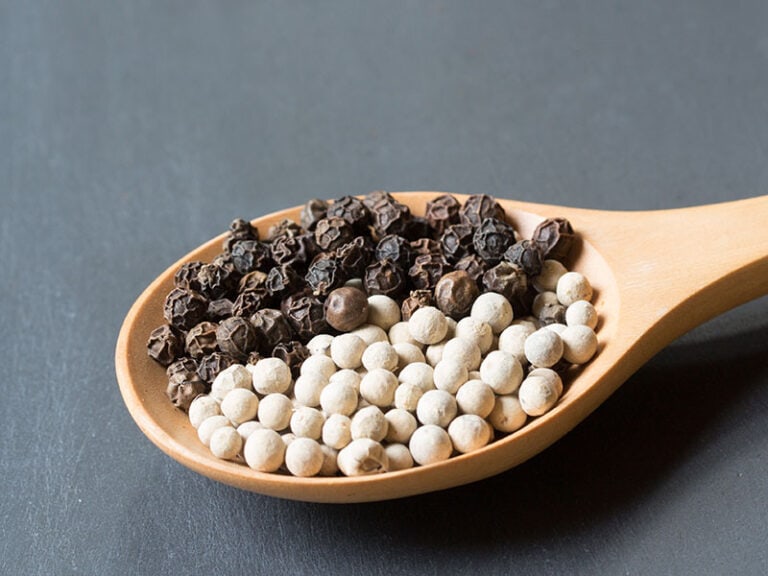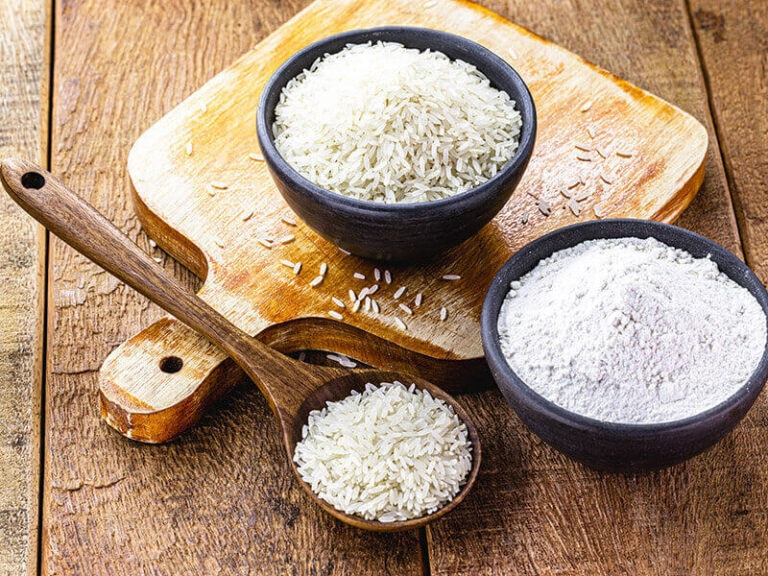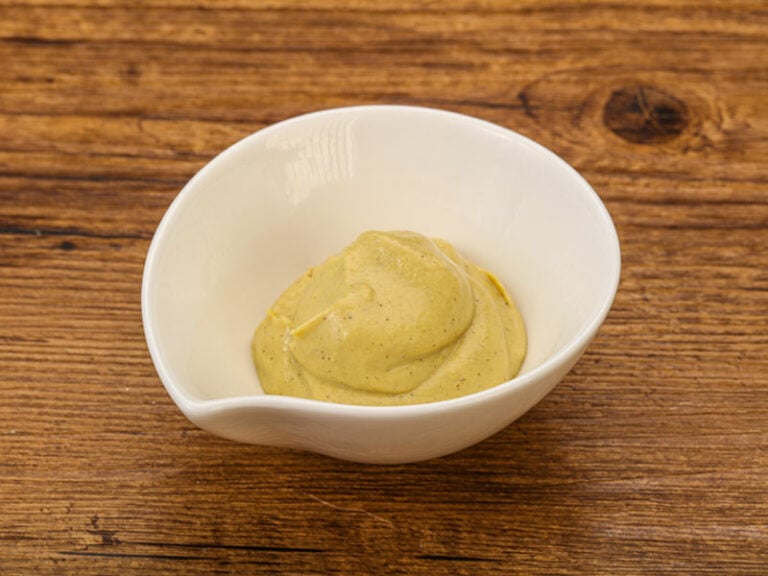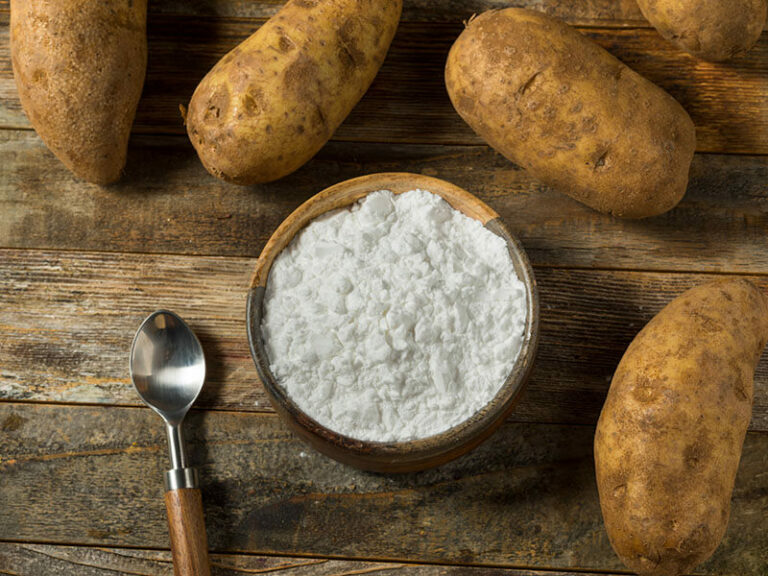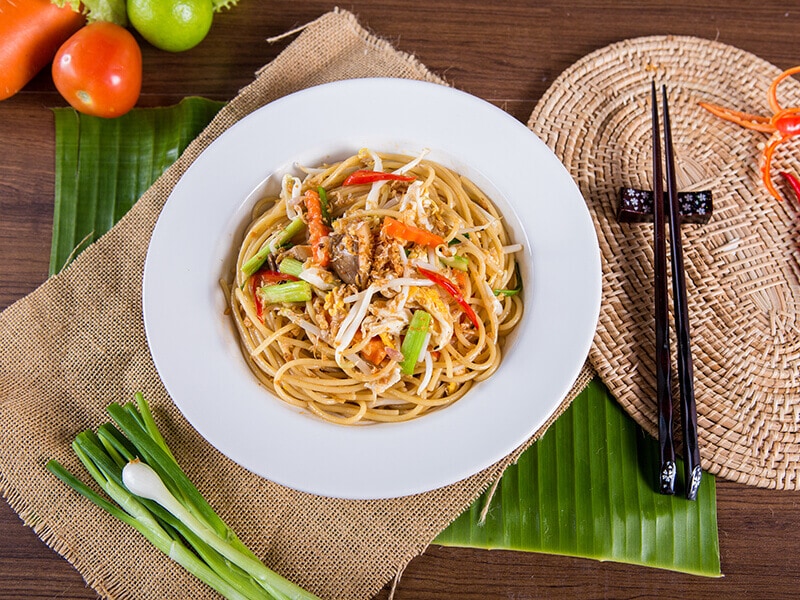
Lo mein vs chow mein, do you know the differences between them? Or, are they identical to one another? I bet that you have at least tried one of them. If you taste both, you will notice a small difference in texture. But is that the only thing that makes people confused? No, there are more.
Noodle lovers should not miss this article. I will show you all of the information about their similarities and differences so that you can tell them apart whenever you have to. The most delicious lo mein and chow mein recipes are also given to you at the end.
Let’s Learn About Lo Mein
Before telling you the similarities and differences between lo mein and chow mein, I will first introduce each type of noodles, so you have some background about what they are. Let’s start with lo mein.
As you may have noticed, “lo mein” is not an English name. It is actually derived from the Chinese name “lāo miàn” (1). “Lāo” means to stir, and “miàn” means noodles. Put together, lo mein is a stirred noodle dish.
Lo mein’s main ingredient is Chinese noodles, but you can make this dish with leftover pasta as well. Then, mix the noodles with vegetables, meat, and seasonings such as peppers, minced garlic, and spring onions. The sauce used for lo mein is soy sauce and oyster sauce.
For people wondering if lo mein is vegan-friendly, I have bad news. A bowl of lo mein is made by boiling the noodles, meat, and vegetables individually, then mixing them together and stirring them with the sauce. Its unique sweet and savory taste makes many people fall in love with it.
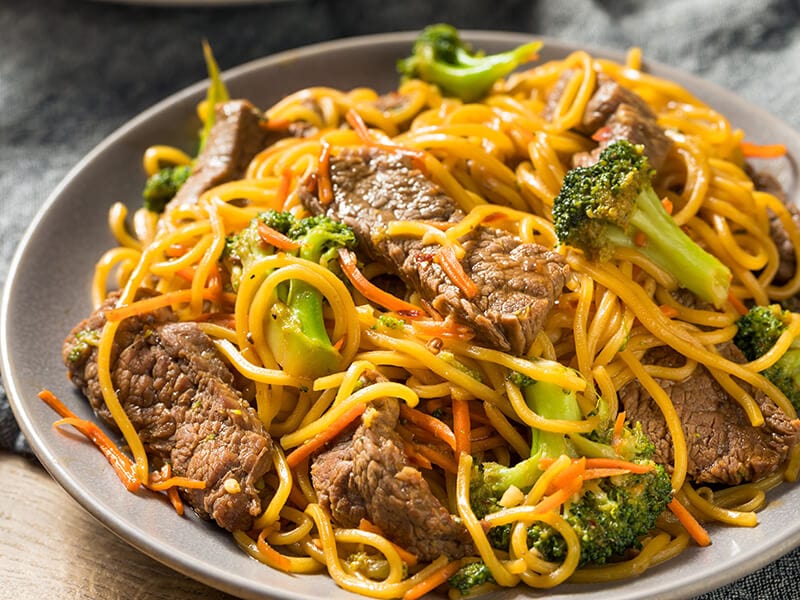
So, What Is Chow Mein?
Let’s turn to chow mein! It is also an amazing noodle. Similar to lo mein, chow mein is also a Chinese-style noodle.
Chow mein is made from vegetables, meat, usually chicken and beef, and sauce. Not only in China, but it is also a popular side dish in Asian cuisine and other Western countries, including America, Canada, and Australia.
The taste and cooking method slightly varies between countries, but the basic method remains the same.
Chow mein itself has two different varieties. They are steamed chow mein and crisp chow mein.
In steamed chow mein, the noodles are soaked and stir-fried with meat, vegetables, and sauce. Crisp chow mein noodles are compressed until they fit the width of the pan. Then the toppings and sauce are drizzled on the top. The noodles’ texture is crispy instead of soft.
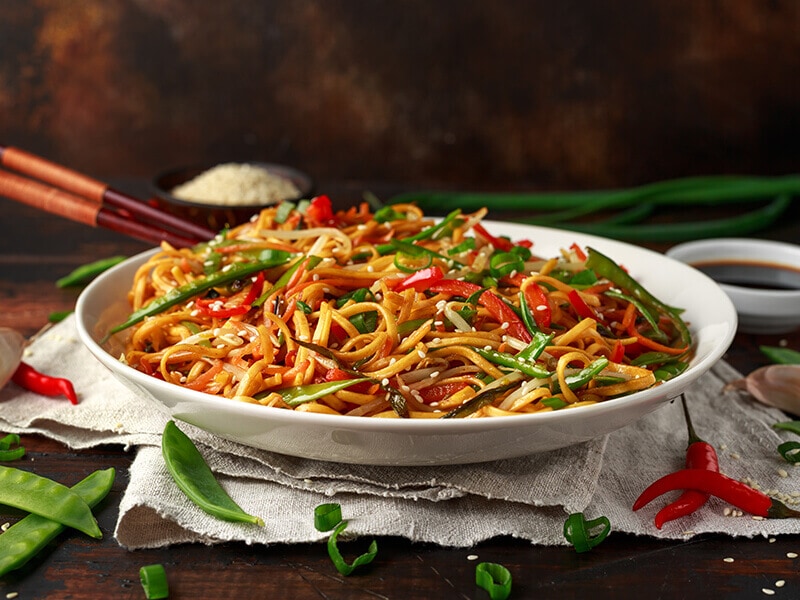
Why Do Most People Can’t Tell Apart Lo Mein And Chow Mein?
It is true that people often use “lo mein” and “chow mein” interchangeably. It is difficult to distinguish between them if you don’t know a lot of them. Now you already have some general information about each of them. It’s time to compare them in every detail.
Regarding similarities, both come from China and have become popular all over the world. They are considered the signature dishes of Chinese cuisines. You will see them in every Chinese restaurant.
They almost have the same toppings. Both lo mein and chow mein include vegetables and some protein-rich food such as chicken, shrimp, and beef. The main ingredient of the sauce is light and dark soy sauce, oyster sauce.
Both lo mein and chow mein use Chinese egg noodles. Although the textures of the noodles are different, both dishes actually use the same kind of noodles, the very noodle kinds often appearing in ramen bowls. I will explain why their texture is different in the next section.
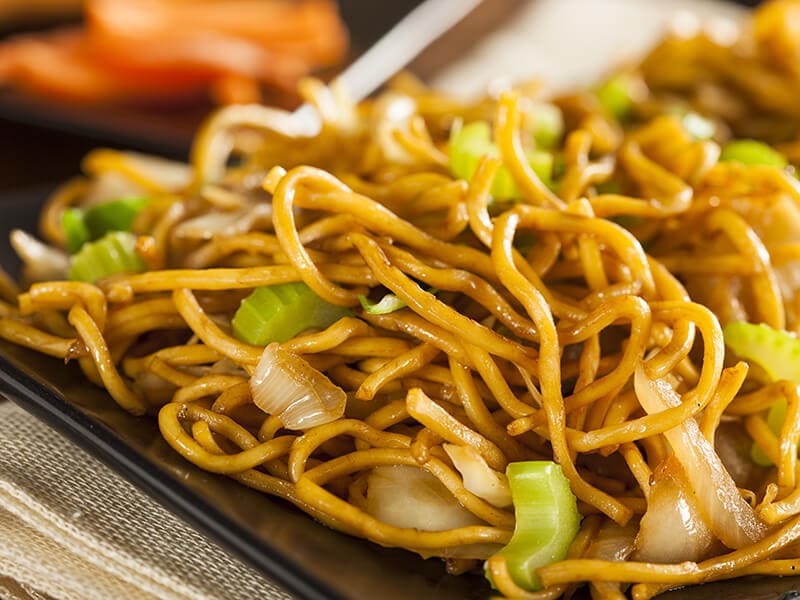
Lo Mein And Chow Mein: What Are The Differences?
Besides these similarities, lo mein and chow mein are not alike in other aspects. For a brief preview, see the table below.
Origin
Although lo mein and chow mein both originate from China. They actually come from different geographical regions. While lo mein was first found in Northern China, chow mein takes root in Guangdong, a city that belongs to Southern China.
Literal Meaning
Lo mein and chow mein both mean noodles. However, lo mein is actually derived from the Chinese name “lāo miàn” (1). “Lāo” means to stir, and “miàn” means noodles. Put together, lo mein is a stirred noodle dish.
As for chow mein, its name “chāu miàn” can be interpreted as “stir-fried” noodles.(2)
Type Of Noodles
I have mentioned above that both lo mein and chow mein use Chinese egg noodles. Lo mein always uses fresh egg noodles to make sure that the strands are soft and tender.
Steamed chow mein often uses fresh egg noodles. However, crisp chow mein tends to use dried egg noodles to create the crunchy texture.
Main Ingredients
Both lo mein and chow mein are made with meat and vegetables. Yet crisp chow mein is sometimes made without vegetables. In addition, while lo mein often contains pork, beef, chicken, shrimp, and tofu, chow mein rarely includes shrimp and tofu.
Sauce Ingredients
Lo mein and chow mein have some dissimilarities in how the sauce is made. Both use soy sauce, and oyster sauce. But lo mein often uses both dark and light soy sauce.
Furthermore, lo mein sauce contains sesame oil, garlic, ginger while cornstarch, chicken broth and sugar is often added to chow mein.
Time Needed For Boiling Noodles
Both low mein and chow mein have to be preprocessed before cooking. And the methods are not the same.
Lo mein noodles are boiled for 2-3 minutes until they are tender. However, chow mein noodles are just parboiled, which means that they are soaked in hot water for 5-6 minutes to soften.
Texture
While lo mein and chow mein use the same kind of noodles, that is Chinese egg noodles, they are cooked differently. Lo mein noodles are softer and more tender because they are thoroughly cooked before being tossed with sauce and other ingredients.
Chow mein noodles, however, are partly softened by immersing them in hot water. After that, they are stir-fried in the pan with vegetables and meat.
Sauce
Sauce is the most important ingredient that creates the taste for noodles. Yet, the sauces used in lo mein and chow mein are dissimilar.
Specifically, chow mein has less sauce than lo mein and it is also lighter, probably because chow mein focuses more on the crispiness of noodles. It can even be made without sauce. In lo mein, the sauce is the soul of the whole dish. The sauce in lo mein is richer and more savory.
Preparation Method
Both lo mein and chow mein need to be made tender before cooking. However, their preprocessing methods are not the same.
Since lo mein is simply tossed noodles, they need to be fully tender. People always boil them until they reach the desired degree of tenderness. On the other hand, chow mein noodles are just soaked in hot water because they will be stir-fried later on.
Cooking Method
This is a main difference between lo mein and chow mein, which leads to the variation in texture.
When making chow mein, people put the parboiled noodles, meat, and vegetables in the wok, and stir-fry them. The sauce is drizzled over the noodles later on. On the other hand, lo mein is literally tossed noodles. All ingredients are fully cooked and mixed together.
Wok Method
Both lo mein and chow mein are cooked in woks. But they are not used in the same way.
In lo mein noodles, the wok is used only for tossing the noodles, soup, and other ingredients. Chow mein noodles, people pour some oil into the wok and set the stove to high heat, then add all of the ingredients and stir-fry them quickly.
Noodle Shape
You can easily distinguish between lo mein and chow mein by paying attention to their noodle shapes. Lo mein noodles always have the typical round shape of Chinese egg noodles, even after they are cooked.
However, chow mein noodles, specifically crispy chow mein noodles, have a flattened shape.
Nutrients
Although almost having the same ingredients, lo mein and chow mein are not equally nutritious. They both provide protein and fiber for your body from vegetables and meat, yet they can be unhealthy in different ways.
Lo mein is made of a lot of soy sauce, so it is higher in sodium. On the other hand, chow mein is stir-fried in oil, which results in more fats.
4 Best Lo Mein Recipe To Add To Your Menu
Is lo mein your favorite noodle? If yes, check out these delicious recipes. Don’t miss anything about it.
1. Crockpot Chicken Lo Mein
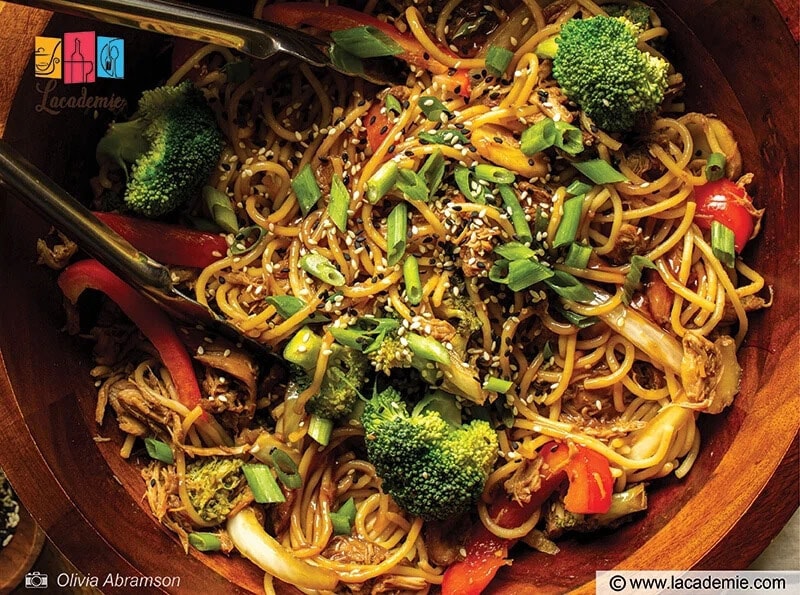
Chicken can never go wrong with lo mein. This meat is actually used to make the classic Chinese lo mein.
The recipes featured here have more ingredients than the simple version. However, the more ingredients it has, the more flavorful it will be. Enjoy the sweet and savory taste of chicken lo mein today.
Try a new tasty chicken lo mein recipe today! Watch this video:
2. Beef Lo Mein
Beef lo mein is made similar to chicken lo mein, the only difference is the meat. Beef is the second most popular meat to go with lo mein.
Beef is a bit sweeter than chicken. If you are not a fan of chicken, beef lo mein is a great alternative. You will see this side dish on every Chinese restaurant’s menu. Yet, this homemade version is equally tasty and also healthier.
3. Vegetable Lo Mein
This is a great option if you are a vegetarian. You can make a lo mein dish full of healthy toppings such as mushrooms, snow peas, and carrot.
To make the dish healthier and lower in sodium, you can adjust the amount of soy sauce or use the low-sodium version.
Vegetable lo mein tastes even more delicious with this recipe. Watch this video:
4. Shrimp Lo Mein
If you like seafood, you will also like shrimp lo mein. The mild sweetness and succulence of shrimp combined with the softness of noodles will give you the best taste of lo mein.
Go for this dish. You will be surprised by how delicious it is. You can make it with just some ingredients and 15 minutes.
4 Delicate Chow Mein Ideas To Serve With Asian Meals
If you cannot stop yourself from falling in love with chow mein, I have some recipes to help you to get the best taste of chow mein.
1. Chicken Chow Mein
Similar to lo mein, chicken is the standard meat used to make chow mein. Its tasty and versatile nature makes it one of the most loved meats in Asian cuisine.
Traditional chow mein is made of Chinese fresh egg noodles. If you don’t have them, you can substitute them with dried pasta.
Make the tastiest chicken chow mein right away! Check out this video to know:
2. Crisp Chow Mein
Crisp chow mein is a unique dish that you should try at least once in your life. If you make it at home, you can use less oil or bake the noodles to reduce the fat content.
The name already tells how it is different from ordinary chow mein. This chow mein has a crispy texture. Its taste is not different from typical chow mein, which is both sweet and salty. Feel free to choose any toppings that you like and make the crispiest chow mein ever.
3. Vegetable Chow Mein
You can make vegetable lo mein, so why not also make vegetable chow mein? Everything is possible when it comes to vegetables.
In contrast to the smooth and tender texture of vegetable lo mein, this dish is a combination of softness and crispiness, making it more flavorful to taste.
4. Soy Sauce Chow Mein
Run out of meat and vegetables? Don’t worry. Unless you don’t even have chow mein noodles, there is still a way to go.
Soy sauce chow mein is different from other kinds of chow mein since it tastes more saucy. The sauce is the star of the dish. You can also add fried eggs, they pair very well with soy sauce.
You can hardly image how tasty this soy sauce chow mein is until you cook it, watch this video:
FAQs
It’s time for questions and answers. Here are the questions that are most often asked when it comes to lo mein and chow mein. Don’t miss them!
You Will Never Get Confused Between Lo Mein And Chow Mein
Lo mein vs chow mein noodles, they are not the same although they are similar in certain aspects, such as origin and ingredients. So which type of noodles is more delicious? The answer entirely depends on your preference. They are both very mouth-watering.
After reading this article, you’ve gained a lot of knowledge about lo mein and chow mein. They cannot confuse you anymore. If you find it helpful, share it with anyone who also loves lo mein and chow mein.
Which type of noodles is your favorite? I like both of them. Share your idea now in the comment box.
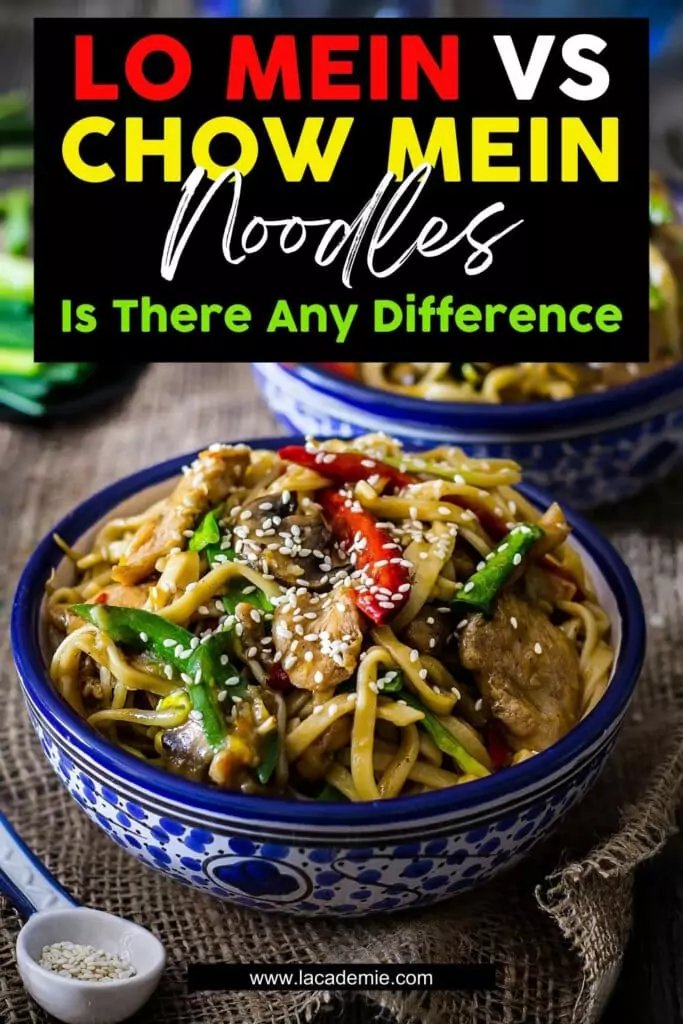
References
- Anon, 2021. Lo Mein. Wikipedia. [online] Available at: <https://en.wikipedia.org/wiki/Lo_mein>
- Anon, 2021. Chow Mein. Wikipedia. [online] Available at: <https://en.wikipedia.org/wiki/Chow_mein>

